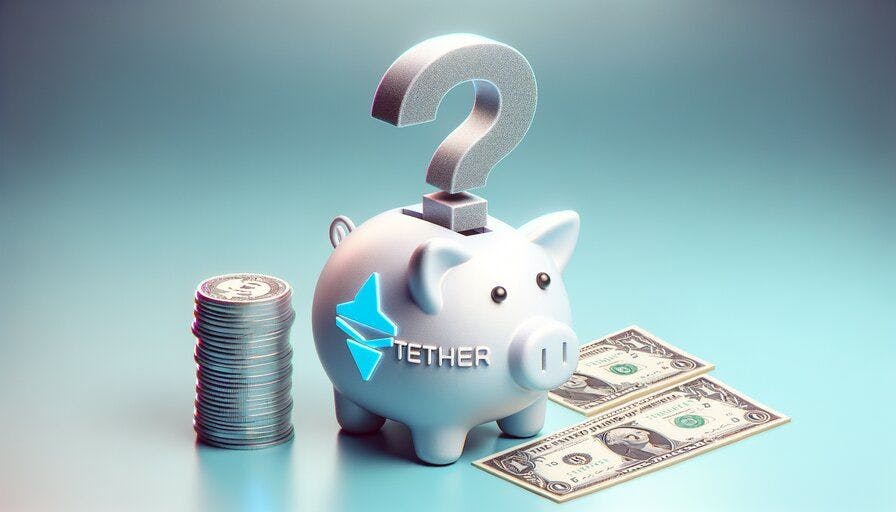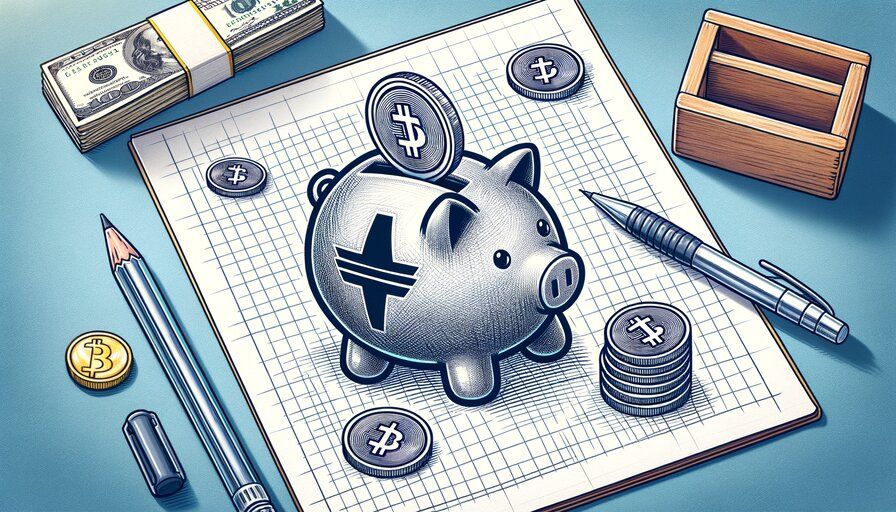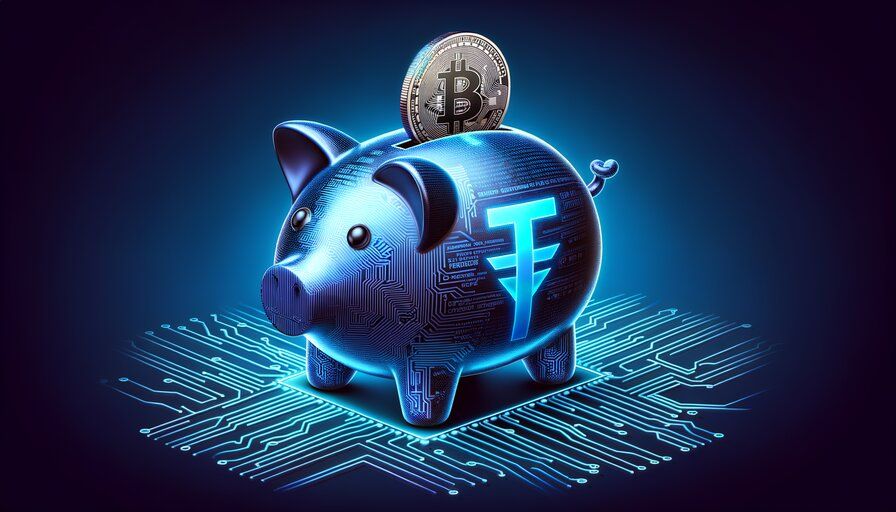
Is it Safe to Put Money in Tether?
19 Mar 2024

19 Mar 2024
Have you ever wished you could keep your money in a digital form that stays as steady and reliable as the dollars in your wallet? That's the idea behind Tether (USDT), a type of digital currency designed to mirror the value of the US dollar. It's like having a digital dollar that you can use online. This makes Tether a popular choice for those interested in the digital currency world without the roller coaster ride of price changes that come with other cryptocurrencies like Bitcoin.
But the big question on everyone's mind is: Is USDT safe? Think of Tether as a digital piggy bank that uses technology to secure your USDT money as much as possible. It aims to provide a safe haven for your funds, keeping its value stable, similar to traditional money but in the digital realm. However, just like any decision involving where to keep your money, whether it be under your mattress, in a bank, or in a digital piggy bank like Tether, it's essential to consider how it works and the measures in place to protect your funds.

Tether (USDT) acts as a digital bridge between the traditional currencies we use every day, like dollars, and the fast-moving world of cryptocurrency. It's designed to offer the best of both worlds: the stability of fiat currency (like the US dollar) with the flexibility and speed of digital currency. In this section, we'll break down how Tether works, why it's considered stable, and what makes it a significant player in the world of digital finance.
Imagine you have a dollar bill that can turn digital and travel the world in seconds. That's what Tether, also known as USDT, essentially is. It's a special kind of digital currency called a stablecoin because its main job is to stay as stable in value as the trusty dollar you're familiar with. Tether always aims to keep its value equal to one US dollar.
Why does this matter? While cryptocurrencies can be as unpredictable as a roller coaster ride, Tether offers a smoother, more predictable journey. It combines the quickness and global reach of digital transactions with the steadiness of the dollar. Whether sending money, paying for something, or saving, Tether tries to ensure your digital dollars hold their value, just like the cash in your pocket.
By bridging the gap between traditional money (like the dollars, euros, or yen) and the futuristic world of cryptocurrencies, Tether provides a reliable and efficient way to manage money digitally. This section will dive deeper into how Tether works, why it's designed to be as dependable as your daily currency, and what that means for you in the digital age.
Navigating the world of stablecoins is like comparing different safety nets. Each one is designed to catch you with stability in the often turbulent world of cryptocurrency. Tether (USDT), USD Coin (USDC), and Binance USD (BUSD) are three of the most popular stablecoins, but how do they differ? Let's take a closer look.
Tether (USDT): Tether is the veteran among stablecoins, having been introduced in 2014. Its main appeal is its widespread acceptance across numerous cryptocurrency exchanges and its massive daily trading volume, often surpassing Bitcoin's. Tether promises to maintain a 1:1 value ratio with the US dollar, making it a go-to for traders seeking to avoid market volatility.
USD Coin (USDC): Launched in 2018, USD Coin is seen as a direct competitor to USDT, offering similar 1:1 dollar-backed stability. However, USDC is often praised for its transparency and regulatory compliance, backed by financial audits that verify its reserves. This makes USDC a favorite for those who prioritize security and transparency in their digital transactions.
Binance USD (BUSD): As the name suggests, BUSD is a stablecoin introduced by Binance, one of the world's leading cryptocurrency exchanges, in partnership with Paxos. Like its peers, BUSD attempts to maintain a 1:1 peg to the US dollar. However, the the New York State Department of Financial Services has issued concerns with BUSD and Paxos and Paxos has made statements that it intends to end the relationship with BUSD and Binance.
The Key Differences:
Market Dominance: USDT leads in terms of market presence and volume, making it the most liquid and widely accepted stablecoin.
Transparency and Trust: USDC scores higher on transparency, with regular audits that provide reassurance about the reserves backing the coin.
Ecosystem Integration: BUSD offers unique advantages within the Binance ecosystem, making it ideal for users who are deeply integrated into trading and services on Binance.
Tether (USDT) is like a chameleon in the digital world; it can adapt and exist on multiple digital platforms, known as blockchains. These blockchains are like different highways for digital currencies, and Tether can travel on several of them, including well-known ones like Bitcoin, Ethereum, and Tron.
Each blockchain has its own rules and benefits, like high security against digital theft or the ability to move money quickly and with minimal fees. By operating on several of these blockchains, Tether becomes a versatile digital currency. It can offer the quickest and cheapest route for your transactions, much like choosing the best road for your journey based on traffic and toll costs.
This multi-chain approach is what makes Tether so accessible and helpful. No matter which blockchain you prefer or find most convenient, Tether can likely be used there, making it a friendly and flexible option for sending, receiving, or storing value digitally. It's like having a key that opens several locks, providing you more choices and freedom in the digital currency world.
Playing by the rules is crucial in the digital and traditional worlds of money. These rules protect you, me, and the entire economy from potential problems. Tether, despite being a leading figure in the digital currency space, is no exception to scrutiny and must follow these regulations closely.
However, just as the game of finance evolves, so do the rules. Tether has found itself under the watchful eyes of these financial referees, who push the stablecoin to continuously update its playbook to stay within the lines. This means Tether works hard to ensure it has enough reserves—essentially, enough real money in the bank—to back up every digital dollar it issues and to operate transparently so everyone can see how it's doing.
For anyone using or thinking about using Tether, this commitment to compliance and transparency is reassuring. It means Tether is actively working to align with legal standards designed to secure your digital dollars. So, as Tether adapts to these evolving rules, it aims to ensure its users can continue to rely on its stability and reliability as a digital counterpart to traditional money.
USDT, being a stablecoin, plays a pivotal role in helping investors and traders navigate the often turbulent waters of cryptocurrency markets. Its stability pegged one-to-one with the US dollar, offers a safe harbor against the high seas of market volatility. This stability is precious for those looking to secure their gains or minimize potential losses. By converting volatile assets into USDT, traders can effectively pause their exposure without moving their funds into traditional banking systems, dodging high transaction fees and potential tax implications, depending on regional regulations.
Hedging Against Market Swings
Utilizing USDT as a hedge, investors can protect themselves against the unpredictable movements of the crypto market. This approach allows for maintaining engagement with the market while safeguarding the value of one's portfolio. The direct peg to the US dollar ensures that profits can be preserved in USDT, sidestepping the need for frequent conversions that can incur costs and complicate tax situations.
Seamless Value Transfer
Moreover, USDT simplifies the process of shifting value across different cryptocurrency assets. For instance, swapping Bitcoin (BTC) for USDT and then purchasing Ethereum (ETH) with USDT could result in lower fees than a direct BTC to ETH exchange. This efficiency also extends to peer-to-peer transactions, enabling users to send and receive funds with the ease of sending an email — a particularly revolutionary advantage for international transfers. Traditional remittance services, with their hefty fees and bureaucratic hurdles, pale in comparison to the straightforward, borderless transactions made possible with USDT.
Empowering Decentralized Finance and Services
USDT's decentralized nature means transactions can bypass intermediaries, fostering a direct connection between parties. Available across the most prominent blockchain networks, USDT's versatility shines in decentralized finance (DeFi) platforms, NFT marketplaces, and a wide array of blockchain-based applications. This wide acceptance across various ecosystems underscores USDT's utility and its significant role in enabling a more efficient and accessible digital economy.
Through these applications, USDT demonstrates its importance beyond just a medium of exchange or a stable store of value. It empowers users with tools for hedging, cost-effective trading, streamlined international transfers, and seamless interaction with decentralized applications, marking it as a cornerstone asset in the realm of digital finance.
Tether (USDT) has become a cornerstone in the burgeoning world of decentralized finance, commonly known as DeFi. This innovative financial landscape relies on blockchain technology to offer services beyond traditional banking, such as lending, borrowing, and earning interest, without central intermediaries. Here's how USDT plays a crucial role in DeFi:
A Stable Foundation in a Volatile World
In the DeFi ecosystem, cryptocurrency values can swing wildly within short periods. USDT, with its stable value pegged to the US dollar, acts as a calm harbor in the stormy sea of cryptocurrency fluctuations. This stability is essential for DeFi platforms, where sudden changes in value can affect lending rates, collateral requirements, and overall investment strategies.
Fueling Liquidity for DeFi Platforms
Liquidity, or the availability of funds for trading and lending, is the lifeblood of DeFi platforms. USDT's steady value encourages participation from investors wary of the volatility associated with traditional cryptocurrencies. This increased participation, in turn, fuels the liquidity of DeFi platforms, making it easier for users to engage in transactions without significant price impacts.
Yield Farming: Earning More from Your Investments
Yield farming, a popular DeFi activity involves lending or staking cryptocurrencies in exchange for interest or rewards. USDT's stability makes it an attractive option for yield farmers looking for predictable returns without exposing themselves to the price volatility of other assets. By using USDT, investors can more accurately calculate potential returns and make informed decisions about where to allocate their funds for maximum efficiency.
Beyond Trading and Lending
But USDT's role in DeFi doesn't stop at lending and trading. It also facilitates a wide range of financial activities, including, but not limited to, providing collateral for derivative products, facilitating stablecoin swaps, and enabling automated asset management strategies. These applications underscore USDT's versatility in supporting not just traditional financial transactions but also innovative financial products and services in the DeFi space.
Despite USDT's widespread use and benefits, there have been concerns about its financial backing:
Tether's Response:
To address these concerns and bolster confidence among users and investors, Tether Limited has taken steps:
These measures aim to maintain trust in USDT's value and its role in the digital currency market.
As we look towards the horizon of digital finance, Tether (USDT) is poised to play an increasingly pivotal role. Here's what to expect:
USDT's role as a stabilizer and facilitator in both the crypto and traditional financial worlds is set to enhance, marking a significant trend that could shape the future of digital and decentralized finance.

Ensuring the safety and stability of a digital currency is crucial for its acceptance and usability. Tether (USDT) incorporates several key features aimed at maintaining its reliability and trustworthiness:
Navigating the digital currency landscape comes with its set of challenges and risks. Tether (USDT), while providing stability and utility, is not exempt from these. Understanding these risks and Tether's mitigation measures is crucial for users and investors.
In response to these risks, Tether has instituted several security measures to protect its ecosystem and users:

Tether (USDT) combines the efficiency of cryptocurrency transactions with the stability of fiat currencies, presenting itself as a compelling choice for those looking to navigate the crypto market's volatility more safely. Despite facing inherent risks, such as regulatory scrutiny and questions about reserve transparency, the widespread acceptance and utility of USDT across the cryptocurrency and traditional finance sectors highlight its significant role. For investors and traders contemplating incorporating USDT into their portfolio, the decision should factor in their risk tolerance and the constantly evolving regulatory landscape.
Holding USDT securely in a reliable USDT wallet adds an additional layer of safety. This ensures that one's digital assets are protected while capitalizing on Tether's potential to act as a stable medium of exchange and value storage. This consideration of using a USDT wallet is crucial for anyone looking to make the most of their investment in Tether, blending security with the strategic advantages that USDT offers.
What is the danger of USDT?
Like any stablecoin, USDT's primary concerns revolve around its reserve backing and transparency. If Tether Limited cannot prove it has enough reserves to back each USDT, there could be trust issues. Additionally, regulatory scrutiny poses a potential risk.
Is USDT safe to invest in?
USDT is generally considered safe for investment, especially as a means to hedge against the volatility of other cryptocurrencies. However, like any investment, it comes with risks, and it's essential to consider Tether's efforts to maintain transparency and regulatory compliance.
Is my money safe in USDT?
When navigating the digital currency space, a pressing question for many is: "Is USDT safe?" In particular, you might wonder about the safety of your funds when stored or used in USDT. The safety of USDT hinges on several critical factors that Tether, the company behind USDT, prioritizes:
Is USDT legal in the USA?
Yes, USDT is legal in the USA. However, it's subject to regulatory oversight and scrutiny. The legal landscape for cryptocurrencies is evolving, so it's essential to stay informed about any changes that might affect the use of USDT and other digital assets.
—
Written by Becki Ranchesia

Becki blends serious intellect with a touch of whimsy in the blockchain domain. You can find her diving into complex ideas with clarity and perhaps a hint of playfulness. When not talking about blockchain, she is busy working on creative digital projects and following evolving tech trends. Her approach marries rigorous analysis with an accessible, engaging style.